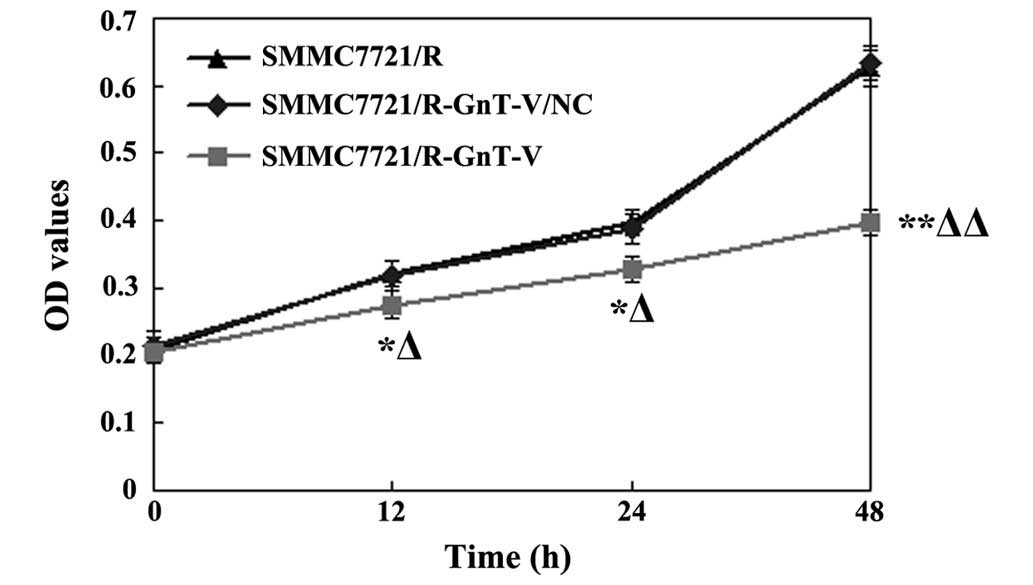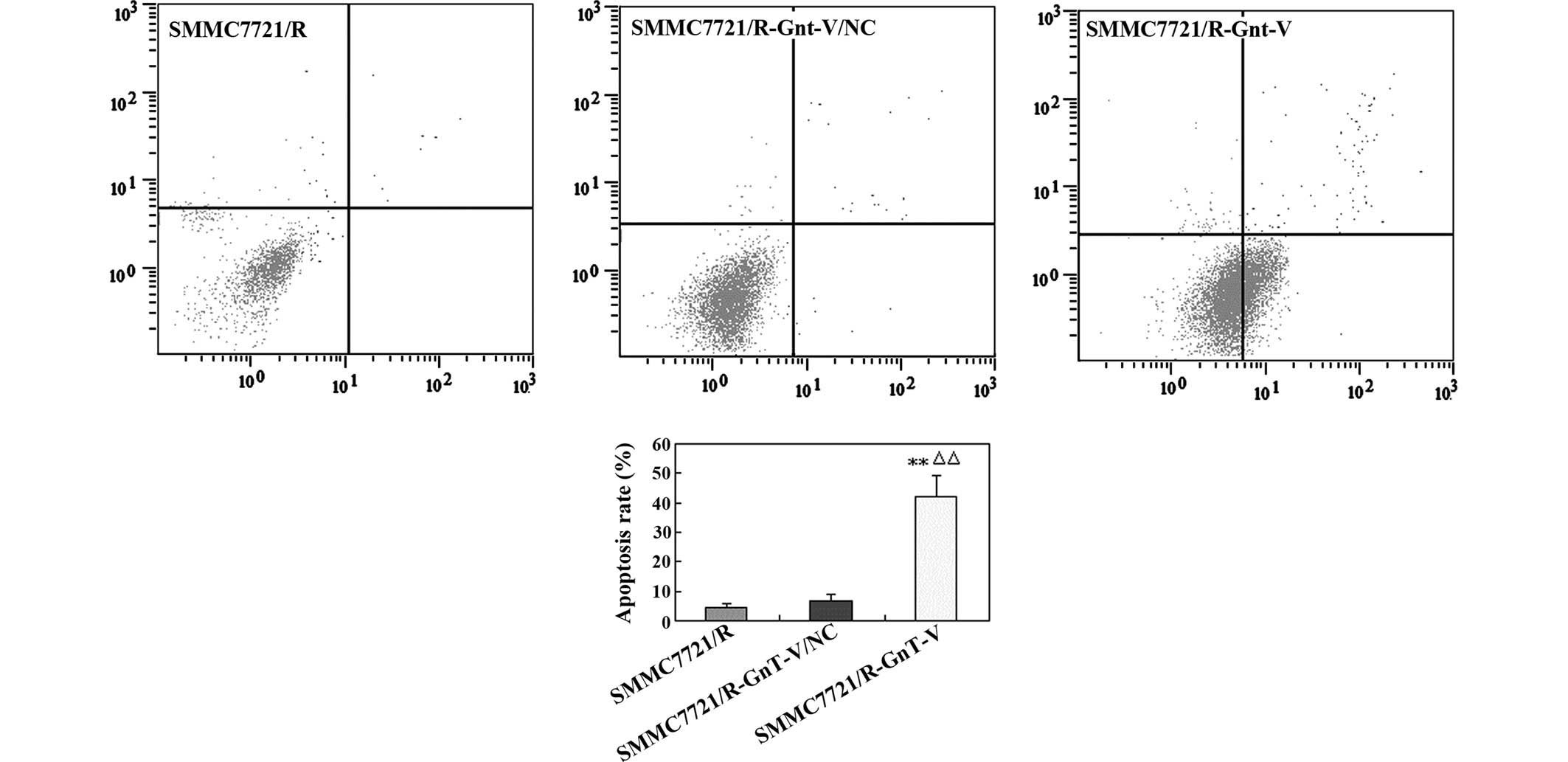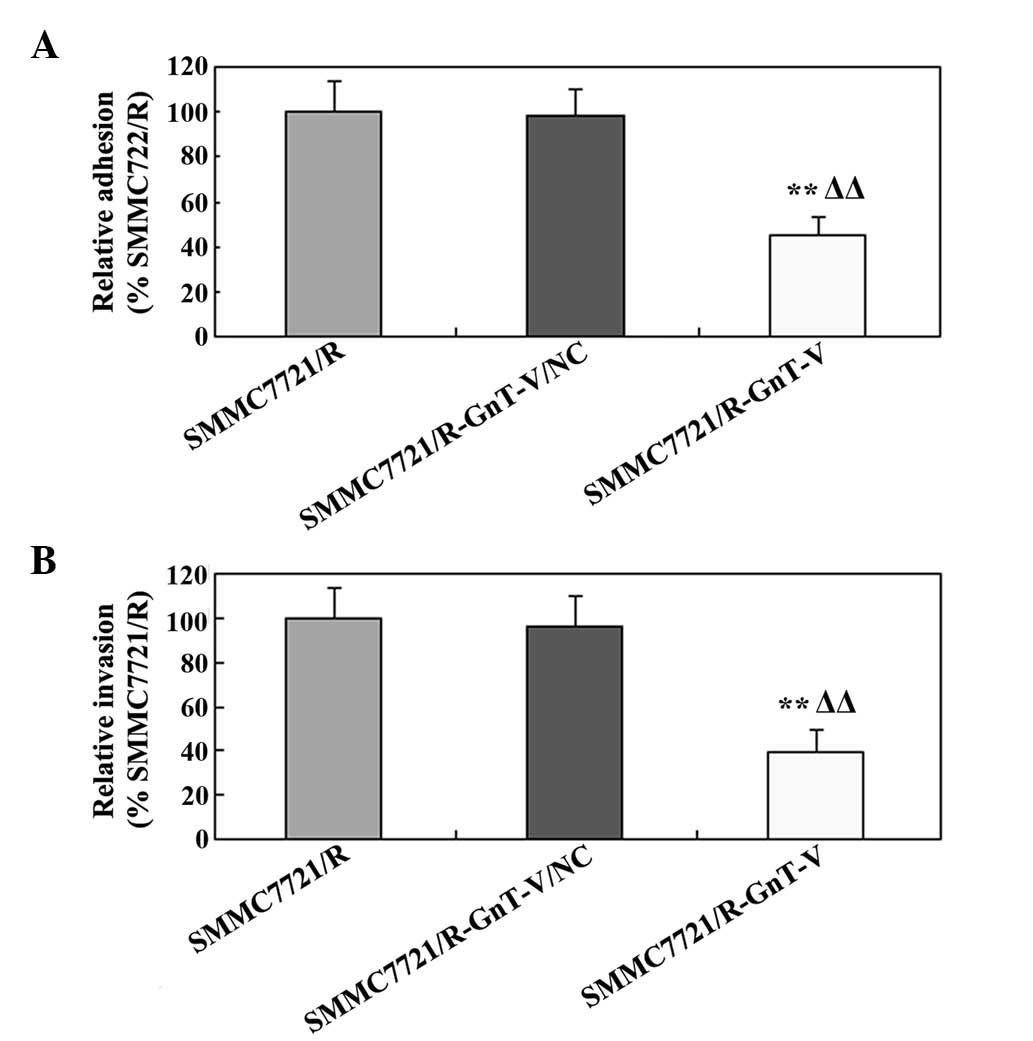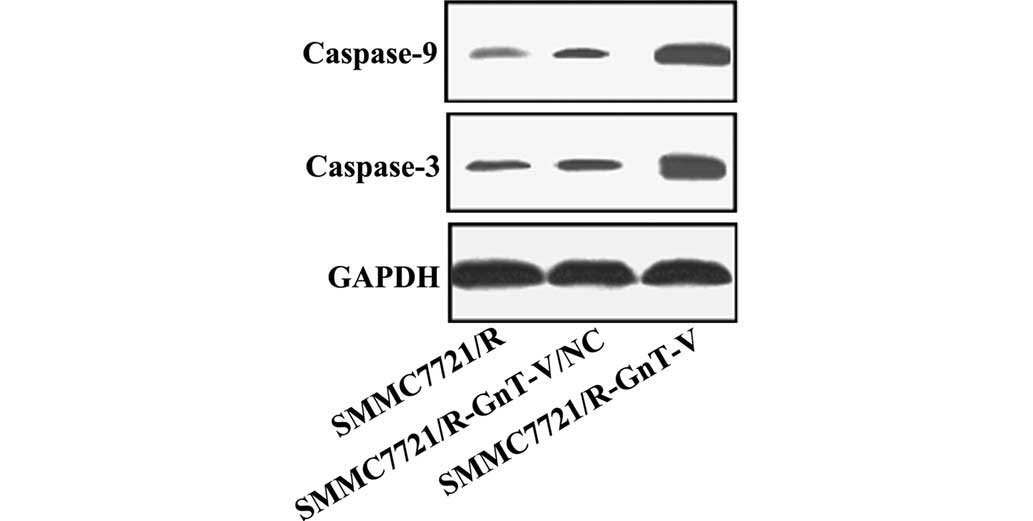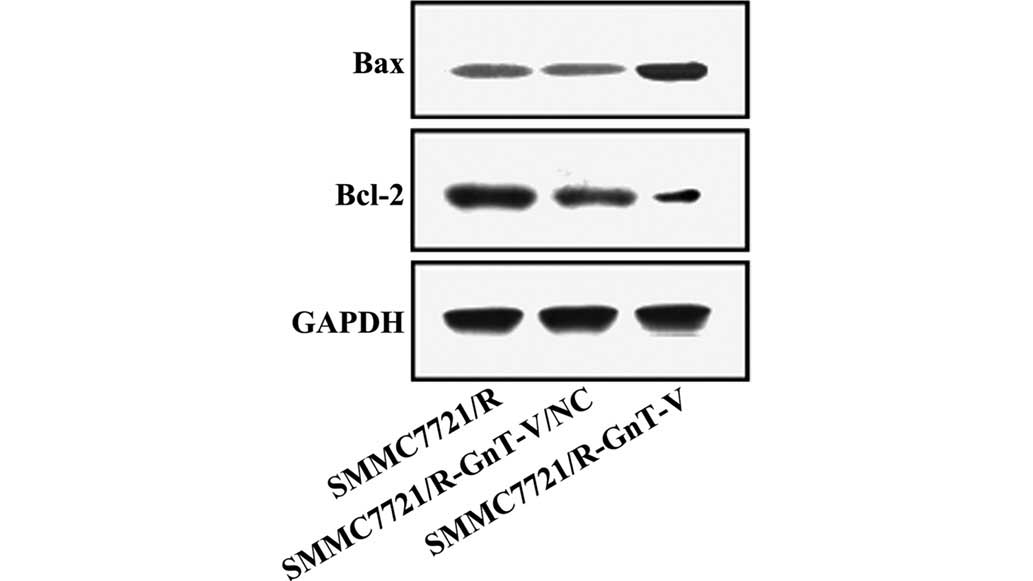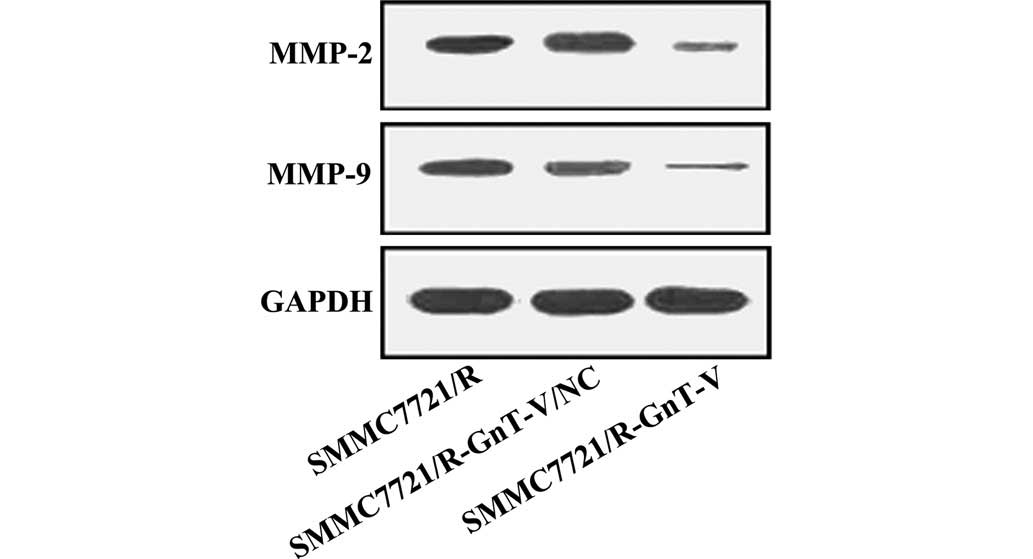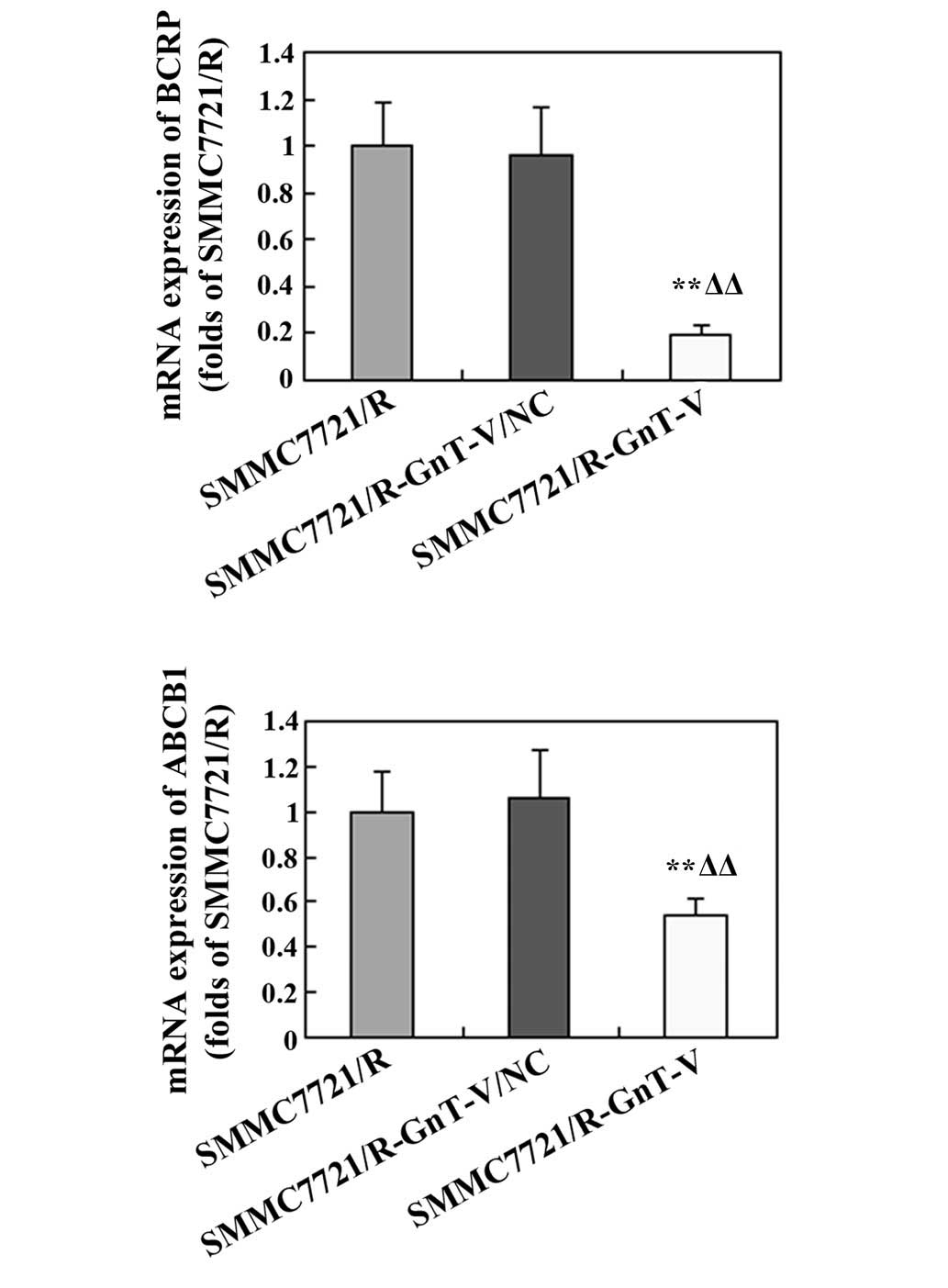Effect of GnT-V knockdown on the proliferation, migration and invasion of the SMMC7721/R human hepatocellular carcinoma drug-resistant cell line
- Authors:
- Published online on: October 29, 2015 https://doi.org/10.3892/mmr.2015.4492
- Pages: 469-476
Abstract
Introduction
Hepatocellular carcinoma (HCC) is one of the most common malignant tumor types, with a rate of incidence that is increasing worldwide (1). According to the 'Word Cancer Report 2014' of the Word Health Organization, new cases reported of HCC and the mortality rate in China are the highest worldwide, with an incidence rate of ~25.7/100,000 individuals (2). Previous studies reported that the predominant risk factor of HCC in China is chronic infection by hepatitis B virus, although other major risk factors include infection with the hepatitis C virus, an excessive alcohol consumption, tobacco smoking and aflatoxins (3–5). At present, observable symptoms of HCC at an early stage are lacking, and therefore clinically symptomatic HCC is often only identified when the disease is already well advanced in patients, which makes treatment difficult, and the prognosis is poor (1). In common with a number of other types of tumor, distant metastasis is the major cause of mortality for patients with HCC. Therefore, the ability to control the dissemination of cancer cells at an early stage is the focus of numerous studies.
N-glycosyltransferase-V (GnT-V), as a key member of the glycosyltransferase family, is closely associated with the proliferation, migration and invasion of cancer cells (6–7). Previous studies reported that GnT-V is commonly overexpressed in various advanced tumor types, including prostate cancer, oral squamous cell carcinoma, colorectal and breast cancer, gastric cancer cells and ovarian mucinous cancer (8–13). Notably, previous studies identified that the downregulation of GnT-V markedly suppressed the proliferation and migration of tumor cells, and induced cell apoptosis (11,14,15). Preliminary experiments in our laboratory demonstrated that GnT-V is highly expressed in SMMC7721 cells (unpublished data), although the effect of reducing the expression of GnT-V on the proliferation, migration and invasion of SMMC7721/R cells remains to be fully elucidated.
In the present study, the role of GnT-V-knockdown on the growth of human HCC was investigated. The expression of GnT-V was suppressed in SMMC7721/R cells using short hairpin (sh)RNA analysis, and the effects of GnT-V-knockdown on the proliferation, adhesion, invasion and apoptosis of the SMMC7721/R cells in vitro were examined. Furthermore, the potential mechanisms underlying the observed effects were investigated using western blotting and reverse transcription-quantitative polymerase chain reaction (RT-qPCR).
Materials and methods
Reagents and cell lines
The human SMMC7721 HCC cell line was obtained from the Shanghai Cell Bank of the Chinese Academy of Sciences (Shanghai, China). The human HCC drug-resistant cell line (SMMC7721/R) was developed from the SMMC7721 cell line using continuous exposure to adriamycin, as previously described (16). The 3-(4,5-dimethylthiazol-2-yl)-2,5-diphenyltetrazolium bromide (MTT), 0.25% trypsin solution, sodium dodecyl sulfate (SDS), phosphate-buffered saline (PBS) and Giemsa stain were obtained from Sigma-Aldrich (St. Louis, MO, USA). The annexin V/fluorescein isothiocyanate (FITC) kit and Matrigel™ were purchased from BD Biosciences (San Jose, CA, USA), and Transwell® culture chambers were purchased from Corning Costar, Inc. (Corning, NY, USA). Propidium iodide (PI) was purchased from Beyotime Institute of Biotechnology (Jiangsu, China). Rabbit GAPDH polyclonal antibody (cat no. sc-25778; 1:200 dilution), rabbit B-cell lymphoma 2 (Bcl-2) polyclonal antibody (cat no. sc-492; 1:200 dilution), rabbit Bcl-2-associated X protein (Bax) polyclonal antibody (cat no. sc-493; 1:200 dilution), rabbit matrix metalloproteinase (MMP)-2 polyclonal antibody (cat no. sc-10736; 1:200 dilution), rabbit MMP-9 polyclonal antibody (cat no. sc-10737; 1:200 dilution) and goat-anti-rabbit horseradish-peroxidase-conjugated secondary antibody (cat no. sc-2004; 1:10,000 dilution) were obtained from Santa Cruz Biotechnology, Inc. (Dallas, TX, USA). Rabbit polyclonal antibody to active caspase-3 (cat no. ab2302; 1:200 dilution) and rabbit polyclonal antibody to active caspase-9 (cat no. ab2324; 1:200 dilution) were obtained from Abcam (Cambridge, MA, USA). The enhanced chemiluminescence (ECL) reagent was provided by Beyotime Institute of Biotechnology (Haimen, China).
Cell culture and transient transfection
The SMMC7721/R cells were cultured in Gibco BRL® RPMI-1640 medium, supplemented with 10% fetal bovine serum (Thermo Fisher Scientific, Inc., Waltham, MA, USA) and 1% penicillin and streptomycin (Beyotime Institute of Biotechnology) at 37°C in a 5% CO2 humidified atmosphere.
The expression of GnT-V was knocked down using short-hairpin (sh)RNAs in a pGenesil-4 shRNA lentiviral vector provided by Wuhan Cell Marker and Machine Technology Co., Ltd. (Wuhan, China). The recombinant lentiviruses were transfected into SMMC7721/R cells using Invitrogen® Lipofectamine 2000 reagent (Thermo Fisher Scientific, Inc.). The stably transfected cells were selected in RPMI-1640 medium, containing G418, and were termed SMMC7721/R-GnT-V and SMMC7721/R-GnT-V/NC, (signifying treatment with control vector, or as a control group, respectively).
RT-qPCR
The mRNA expression levels of GnT-V, the breast cancer resistance protein (BCRP) and P-glycoprotein [also termed the ATP-binding cassette, subfamily B protein (ANCB1)] were quantified using SYBR Green-based RT-qPCR analysis (Bio-Rad Laboratories, Shanghai, China). The primer sequences are listed in Table I (17,18). The total RNA from cells was isolated using RNAiso Plus extraction reagent (Takara Biotechnology Co., Ltd., Dalian, China). Subsequently, cDNA was synthesized from 1 µg total RNA using PrimeScript™ RT reagent kits (Takara Biotechnology Co., Ltd.). The cDNAs were amplified using SYBR Green mixture on a CFX96 Touch Real-Time PCR Detection system (Bio-Rad Laboratories). The cycle threshold values were normalized against the amplification of GAPDH, and the relative mRNA expression levels of GnT-V, BCRP and ABCB1 were assessed using 2−∆∆Cq relative quantitative analysis of each sample. All samples were analyzed in triplicate.
Table IPrimers for reverse transcription-quantitative polymerase chain reaction used in the present study. |
Western blot analysis
The cells were lysed using western blotting and an immunoprecipitation cell lysis buffer kit (Sangon Biotech Co., Ltd., Shanghai, China) and the total proteins were quantified using a bicinchoninic acid protein assay reagent kit (Sangon Biotech Co., Ltd.). The total protein (20 µg) was loaded onto SDS-polyacrylamide electrophoresis gels (Bio-Rad Laboratories), and subsequently transferred onto a nitrocellulose filter membrane (Bio-Rad Laboratories). Anti-Bcl2, Bax, caspase-3, caspase-9, MMP-2, MMP-9 and GAPDH antibodies were used to assess the corresponding protein expression at 4°C for 12 h. The horseradish-peroxidase-conjugated anti-rabbit and anti-rat immunoglobulins were used as secondary antibodies, and the immunoreactive bands were visualized using ECL-detecting reagents.
MTT assay
A total of 5×103 cells/well were seeded into 96-well plates, and following an incubation for 0, 12, 24 or 48 h, the proliferation of the cells was determined using an MTT assay, according to the manufacturer's protocol. Subsequently, the optical density values were measured at 490 nm using a 96-well plate reader (Thermo Scientific® Multiscan MK3; Thermo Fisher Scientific, Inc.).
Apoptosis assay using flow cytometric analysis
The extent of cell apoptosis was analyzed using an Annexin V-FITC kit (BD Biosciences) according to the manufacturer's instructions. In brief, cells were harvested following an overnight incubation in serum-free medium and 5×104 cells were washed with PBS and stained PI and Annexin V for flow-cytometric analysis on a FACSCalibur flow cytometer (BD Biosciences). The percentage of cells undergoing early-stage apoptosis was determined by quantifying the Annexin V-positive and the PI-negative cell population, whereas the percentage of cells undergoing late-stage apoptosis was determined by quantifying the Annexin V-positive and the PI-positive cell population. Finally, data were analyzed using FlowJo 7.6 software (FlowJo, LLC, Ashland, OR, Canada).
Cell adhesion assay
Matrigel™-coated 12-well plates were used to assess cell adhesion. Prior to use, the cells were grown until they reached 90% confluence on 12-well plates, and they were subsequently cultured in serum-free RPMI-1640 medium for 24 h. The cells were harvested following an overnight incubation in serum-free medium and subsequently suspended in RPMI-1640 medium containing 10% fetal bovine serum (FBS), prior to adding the cells to 12-well plates that were pre-coated with Matrigel™ (2×104 cells/well). Following an incubation for 1 h at 37°C in 5% CO2, the unattached cells were removed by washing the cells twice with warmed PBS, and the number of adhering cells was determined using the Giemsa staining method for 10 min. The stained cells were observed under an optical microscope (IX53; Olympus, Tokyo, Japan).
In vitro invasion assay
The invasive ability of the cells was measured using Transwell culture chambers with Matrigel™. Briefly, the cells were grown until they reached 90% confluence on 24-well plates, and they were subsequently cultured in the serum-free RPMI-1640 medium for 24 h prior to use. A series of 24-well plates and Transwell well culture chambers pro-coated with Matrigel™ were washed in PBS for 5 min, and dried immediately. Aliquots of 0.75 ml RPMI-1640 medium supplemented with 10% FBS were added to the upper chamber and 0.5 ml cells (at a density of 1×105/ml) in RPMI-1640 medium, containing 1% FBS, were placed in the upper chamber. Following incubation for 48 h at 37°C in 5% CO2, the number of cells which had invaded through the Matrigel™-coated polyvinylidene fluoride filter was determined by counting the cells stained with 0.5% crystal violet solution. The stained cells were observed under an optical microscope (IX53; Olympus).
Statistical analysis
The data are expressed as the mean ± standard deviation. The data analysis was performed using the SPSS 19.0 statistical software package (IBM SPSS, Armonk, NY, USA), and one-way analysis of variance was used to compare the means between two groups. P<0.05 was considered to indicate a statistically significant difference.
Results
Expression of GnT-V in SMMC7721/R cells following transfection
Following transfection, the expression of GnT-V in the SMMC7721/R cells was determined using RT-qPCR and western blotting. As shown in Fig. 1A, the gene expression of GnT-V was markedly downregulated in the SMMC-7721/R-GnT-C cells compared with the control and mock groups. This trend was also observed in the protein expression level of GnT-V following transfection (Fig. 1B). These results indicated that GnT-V-knockdown in the SMMC-7721/R cells was successful.
GnT-V-knockdown inhibits the proliferation of the SMMC7721/R cells
The proliferation of the SMMC-7721/R cells was assessed using an MTT assay following transfection. As shown in Fig. 2, compared with the two control cell groups, the proliferation of the SMMC-7721/R-GnT-C cells decreased significantly at 12, 24 and 48 h following transfection (P<0.01 for all the time points). However, no significant differences were identified between the untreated SMMC-7721/R and the SMMC-7721/R-GnT-V/NC groups (P>0.05). These results therefore revealed that GnT-V-knockdown significantly inhibited the proliferation of the SMMC-7721/R cells.
Downregulation of GnT-V enhances cell apoptosis
The extent of cell apoptosis was analyzed using flow cytometry to investigate whether the antiproliferative effect of GnT-V downregulation was associated with apoptosis in the SMMC-7721/R cells. As shown in Fig. 3, the apoptosis rate of the GnT-V knockdown group was significantly higher compared with that in the untreated SMMC-7721/R cells and the SMMC-7721/R-GnT-V/NC group (43.5, 4.2 and 6.3%, respectively), which indicated that decreasing the expression of GnT-V may markedly increase the levels of apoptosis in the SMMC-7721/R cells.
Downregulation of GnT-V inhibits cell adhesion and invasion in vitro
To determine the role of GnT-V on the in vitro adhesion and invasion of the SMMC-7721/R cells, cell adhesion and invasion assays were performed. As shown in Fig. 4A, compared with the untreated cells and the mock group, cell adhesion was significantly inhibited by GnT-V-knockdown in the SMMC-7721/R cell line. Notably, the results of the cell invasion assay were similar to those of the cell adhesion assay (Fig. 4B). The results of these experiments revealed that down-regulating the expression of GnT-V clearly suppressed the adhesion and the invasion of the SMMC-7721/R cells in vitro.
Protein expression levels of caspase-3, caspase-9, Bcl-2, Bax, MMP-2 and MMP-9
Thus far, the experiments performed in the present study revealed that GnT-V-knockdown may inhibit the proliferation, adhesion and invasion of the SMMC-7721/R cells in vitro. To further investigate the possible mechanisms underlying these changes, the protein expression levels of caspase-3, caspase-9, Bcl-2, Bax, MMP-2 and MMP-9 were assessed by western blotting. As shown in Figs. 5Figure 6–7, no significant differences were observed between the untreated SMMC-7721/R cells and the SMMC-7721/R-GnT-V/NC group with respect to the expression levels of any of the proteins. Notably, compared with the untreated SMMC-7721/R cells and the SMMC-7721/R-GnT-V/NC group, the protein expression levels of caspase-3, caspase-9, Bcl-2, MMP-2 and MMP-9 were clearly decreased in the GnT-V knockdown group, whereas the protein expression of Bax was markedly upregulated.
mRNA expression levels of BCRP and ANCB1
To further examine whether GnT-V-knockdown affected the drug-sensitivity of the SMMC-7721/R cells, the mRNA expression levels of BCRP and ABCB1 were assessed by RT-qPCR. As shown in Fig. 8, the expression levels of these genes were markedly reduced in the GnT-V-knockdown cells compared with the untreated SMMC-7721/R cells and the SMMC-7721/R-GnT-V/NC group.
Discussion
In the present study, GnT-V knockdown in vitro was revealed to markedly decrease the proliferation, migration and invasion of human HCC drug-resistant SMMC-7721/R cells. In addition, the inhibitory effects may be involved in inducing apoptosis of the cells, in inhibiting the degradation of the extracellular matrix (ECM) and in restoring drug-sensitivity. Previous studies reported that protein glycosylation exerts a crucial role in cell growth, differentiation and tumor metastasis, and β1,6-branched oligosaccharides are key compounds associated with the process of malignant transformation (6,19,20). A previous study demonstrated that GnT-V is an important glycosyltransferase, which promotes this malignant transformation process by catalyzing the formation of β1,6-branched oligosaccharides (19). Furthermore, GnT-V is overexpressed in various malignant tumor types, thereby promoting the malignant transformation process (21,22). Therefore, it was hypothesized that reducing the expression of GnT-V may provide a suitable strategy for ameliorating the progression of certain tumor types. To determine the effect of downregulating the expression of GnT-V on the progression of HCC, a GnT-V-knockdown cell model was successfully constructed by transferring short hairpin (sh) RNA into SMMC-7721/R cells.
As demonstrated by preliminary in vitro experiments in our group, GnT-V-knockdown markedly decreased the proliferation, migration and invasion of human HCC drug-resistant SMMC-7721/R cells (unpublished data). Notably, increased levels of apoptosis were also observed in the GnT-V-knockdown cells. According to these results, the antiproliferative effects of GnT-V-knockdown on SMMC-7721/R cells may be closely associated with the increased apoptosis that is induced by the downregulation of the expression of GnT-V. Apoptosis, or programmed cell death, is a complex biological process, which is important for the development and maintenance of cells. It was reported that caspases exert a crucial role during cell apoptosis (23). Among them, caspase-3 is an important effector of cell mortality, whereas caspase-9 functions as a crucial upstream activator (23). In the present study, the protein expression levels of caspase-3 and caspase-9 were significantly upregulated in the GnT-V-knockdown SMMC-7721/R cells, which was consistent with the results of a previous study performed in H7721 human HCC cells (21). Furthermore, the proteins Bcl-2 and Bax are also essential for cell apoptosis, functioning as the predominant controller and mediator of apoptosis, respectively, and the ratio of Bcl-2 to Bax is a key factor determining whether the switch to apoptosis is made (24,25). The results of the present study demonstrated that the protein expression level of Bcl-2 was downregulated, whereas that of Bax was upregulated. Furthermore, GnT-V-knockdown may increase the expression of Bcl-2, whereas the protein expression of caspase-3, caspase-9 and Bax were decreased. Therefore, inhibiting the expression of GnT-V promoted mitochondrial-associated apoptosis, which is mediated by caspase-3, caspase-9, Bcl-2 and Bax.
Furthermore, previous studies demonstrated that GnT-V exerts an important role in the metastasis/invasion of various types of tumor. For example, a close association was identified between GnT-V activity and tumor invasiveness in the sera of patients with HCC (19). Additionally, in vitro GnT-V-knockdown may decrease the invasive ability of the BGC823 gastric cancer cell line (11). Notably, the present results demonstrated that suppressing the expression of GnT-V markedly reduced cell-to-cell adherence and the invasive abilities of the SMMC-7721/R cells. Cellular metastasis and invasion is a complex and crucial process in cancer. It is well known that cell-to-cell adherence and invasion of the ECM is responsible for malignant neoplasms, and ECM and basement membranes are predominantly degraded by MMPs (26). MMP-2 and MMP-9 exert key roles in degrading the ECM components, and are also important in tumor progression, as demonstrated by their overexpression in advanced tumor types (27,28). The mRNA expression of MMP-2 and MMP-9 were demonstrated to be upregulated in HCCs, although they were expressed with different intensities, and had a different cellular origin (29). The mRNA expression of MMP-9 was higher in HCCs with capsular infiltration compared with HCCs that lacked capsular infiltration, whereas the mRNA expression of MMP-2 exhibited no marked difference between tumorous and non-tumorous tissues (30). In the present study, the protein expression levels of MMP-2 and MMP-9 were markedly decreased in the SMMC-7721/R-GnT-V cells. According to these results, the reduced invasive ability of the SMMC-7721/R-GnT-V cells is closely associated with the downregulation of the protein expression of MMP-2 and MMP-9.
In addition, multidrug resistance (MDR), resulting from the overexpression of MDR proteins, is a major obstacle in cancer chemotherapy. A number of previous studies revealed that MDR proteins are predominantly encoded by ATP-binding cassette (ABC) families, which may mediate drug efflux to the cytomembrane, leading to lower levels of chemicals in the plasma (31,32). BCRP and ABCB1, as members of the ABC transporter family of proteins, are important mediators of MDR in cancer cells (33–35). The overexpression of BCRP and ABCB1 was frequently identified in various tumor types, including HCC, ovarian tumor and breast cancer (36–39). In the present study, the mRNA expression of BCRP and ANCB1 was notably reduced in the GnT-V-knockdown SMMC-7721/R cells, indicating that GnT-V-knockdown may improve the sensitivity of the human HCC drug-resistant cell line, SMMC7721/R, to chemotherapies.
In conclusion, GnT-V-knockdown inhibited the proliferation, migration and invasion of human HCC drug-resistant SMMC7721/R cells in vitro. The underlying mechanisms may be associated with the induction of mitochondrial-mediated apoptosis, a suppression of the degradation of ECM components of the basement membrane, and a strengthening of the drug sensitivity of the cells.
Acknowledgments
The present study was supported by the Support Program of the Department of Science and Technology of Sichuan Province (no. 2009JY0096).
References
|
Lafaro KJ, Demirjian AN and Pawlik TM: Epidemiology of hepatocellular carcinoma. Surg Oncol Clin N Am. 24:1–17. 2015. View Article : Google Scholar | |
|
Stewart BW and Wild CP: World Cancer Report 2014. IARC; Nonserial Publication: 2014 | |
|
Nordenstedt H, White DL and El-Serag HB: The changing pattern of epidemiology in hepatocellular carcinoma. Dig Liver Dis. 42(Suppl 3): S206–S214. 2010. View Article : Google Scholar : PubMed/NCBI | |
|
El-Serag HB and Kanwal F: Epidemiology of hepatocellular carcinoma in the United States: Where are we? Where do we go? Hepatology. 60:1767–1775. 2014. View Article : Google Scholar : PubMed/NCBI | |
|
Kew MC and Kew MC: Hepatocellular carcinoma: Epidemiology and risk factors. J Hepa Carc. 1:115–125. 2014. | |
|
Chakraborty AK and Pawelek JM: GnT-V, macrophage and cancer metastasis: A common link. Clin Exp Metastasis. 20:365–373. 2003. View Article : Google Scholar : PubMed/NCBI | |
|
Song K, Ko JH and Kim YS: Role of N-acetylglucosaminyltra nsferase-V and galectin-3 binding protein in anoikis stress of cancer cells (788.1). FASEB J. 28:781–788. 2014. | |
|
Murata K, Miyoshi E, Kameyama M, Ishikawa O, Kabuto T, Sasaki Y, Hiratsuka M, Ohigashi H, Ishiguro S, Ito S, et al: Expression of N-acetylglucosaminyltransferase V in colorectal cancer correlates with metastasis and poor prognosis. Clin Cancer Res. 6:1772–1777. 2000.PubMed/NCBI | |
|
Handerson T, Camp R, Harigopal M, Rimm D and Pawelek J: β1, 6-branched oligosaccharides are increased in lymph node metastases and predict poor outcome in breast carcinoma. Clin Cancer Res. 11:2969–2973. 2005. View Article : Google Scholar : PubMed/NCBI | |
|
Takahashi N, Yamamoto E, Ino K, Miyoshi E, Nagasaka T, Kajiyama H, Shibata K, Nawa A and Kikkawa F: High expression of N-acetylglucosaminyltransferase V in mucinous tumors of the ovary. Oncol Rep. 22:1027–1032. 2009.PubMed/NCBI | |
|
Huang B, Sun L, Cao J, Zhang Y, Wu Q, Zhang J, Ge Y, Fu L and Wang Z: Downregulation of the GnT-V gene inhibits metastasis and invasion of BGC823 gastric cancer cells. Oncol Rep. 29:2392–2400. 2013.PubMed/NCBI | |
|
Seto K, Uchida F, Baba O, Yamatoji M, Karube R, Warabi E, Sakai S, Hasegawa S, Yamagata K, Yanagawa T, et al: Negative expression of N-acetylglucosaminyltransferase V in oral squamous cell carcinoma correlates with poor prognosis. Springerplus. 2:6572013. View Article : Google Scholar : PubMed/NCBI | |
|
Huang H, Chen W, Liu Q, Wei T, Zhu W, Meng H, Guo L and Zhang J: Inhibition of N-acetylglucosaminyltransferase V enhances sensitivity of radiotherapy in human prostate cancer. Biochem Biophys Res Commun. 451:345–351. 2014. View Article : Google Scholar : PubMed/NCBI | |
|
Guo HB, Liu F, Zhao JH and Chen HL: Down-regulation of N-acetylglucosaminyltransferase V by tumorigenesis- or metastasis-suppressor gene and its relation to metastatic potential of human hepatocarcinoma cells. J Cell Biochem. 79:370–385. 2000. View Article : Google Scholar : PubMed/NCBI | |
|
Taniguchi N, Ihara S, Saito T, Miyoshi E, Ikeda Y and Honke K: Implication of GnT-V in cancer metastasis: A glycomic approach for identification of a target protein and its unique function as an angiogenic cofactor. Glycoconj J. 18:859–865. 2001. View Article : Google Scholar | |
|
Yang JY, Luo HY, Lin QY, Liu ZM, Yan LN, Lin P, Zhang J and Lei S: Subcellular daunorubicin distribution and its relation to multidrug resistance phenotype in drug-resistant cell line SMMC-7721/R. World J Gastroenterol. 8:644–649. 2002. View Article : Google Scholar : PubMed/NCBI | |
|
Li GP, Chen XP and Ye L: The role of BCRP in hepatocellular carcinoma multidrug resistance and mechanism. J Abdom Surg. 5:242006. | |
|
Albermann N, Schmitz-Winnenthal FH, Z'graggen K, Volk C, Hoffmann MM, Haefeli WE and Weiss J: Expression of the drug transporters MDR1/ABCB1, MRP1/ABCC1, MRP2/ABCC2, BCRP/ABCG2, and PXR in peripheral blood mononuclear cells and their relationship with the expression in intestine and liver. Biochem Pharmacol. 70:949–958. 2005. View Article : Google Scholar : PubMed/NCBI | |
|
Yanagi M, Aoyagi Y, Suda T, Mita Y and Asakura H: N-Acetylglucosaminyltransferase V as a possible aid for the evaluation of tumor invasiveness in patients with hepatocellular carcinoma. J Gastroenterol Hepatol. 16:1282–1289. 2001. View Article : Google Scholar | |
|
Dosaka-Akita H, Miyoshi E, Suzuki O, Itoh T, Katoh H and Taniguchi N: Expression of N-acetylglucosaminyltransferase v is associated with prognosis and histology in non-small cell lung cancers. Clin Cancer Res. 10:1773–1779. 2004. View Article : Google Scholar : PubMed/NCBI | |
|
Guo P, Chen HJ, Wang QY and Chen HL: Down regulation of N-acetylglucosaminyltransferase V facilitates all-transretinoic acid to induce apoptosis of human hepatocarcinoma cells. Mol Cell Biochem. 284:103–110. 2006. View Article : Google Scholar : PubMed/NCBI | |
|
Miyoshi E, Terao M and Kamada Y: Physiological roles of N-ac etylglucosaminyltransferase V (GnT-V) in mice. BMB Rep. 45:554–559. 2012. View Article : Google Scholar : PubMed/NCBI | |
|
Nicholson DW: Caspase structure, proteolytic substrates, and function during apoptotic cell death. Cell Death Differ. 6:1028–1042. 1999. View Article : Google Scholar : PubMed/NCBI | |
|
Beerheide W, Tan YJ, Teng E, Ting AE, Jedpiyawongse A and Srivatanakul P: Downregulation of proapoptotic proteins Bax and Bcl-X(S) in p53 overexpressing hepatocellular carcinomas. Biochem Biophys Res Commun. 273:54–61. 2000. View Article : Google Scholar : PubMed/NCBI | |
|
Deng B, Zhang XF, Zhu XC, Huang H, Jia HL, Ye QH, Dong QZ and Qin LX: Correlation and prognostic value of osteopontin and Bcl-2 in hepatocellular carcinoma patients after curative resection. Oncol Rep. 30:2795–2803. 2013.PubMed/NCBI | |
|
Stetler-Stevenson WG, Aznavoorian S and Liotta LA: Tumor cell interactions with the extracellular matrix during invasion and metastasis. Annu Rev Cell Biol. 9:541–573. 1993. View Article : Google Scholar : PubMed/NCBI | |
|
Schmalfeldt B, Prechtel D, Härting K, Späthe K, Rutke S, Konik E, Fridman R, Berger U, Schmitt M, Kuhn W, et al: Increased expression of matrix metalloproteinases (MMP)-2, MMP-9, and the urokinase-type plasminogen activator is associated with progression from benign to advanced ovarian cancer. Clin Cancer Res. 7:2396–2404. 2001.PubMed/NCBI | |
|
Karahan N, Güney M, Baspinar S, Oral B, Kapucuoglu N and Mungan T: Expression of gelatinase (MMP-2 and MMP-9) and cyclooxygenase-2 (COX-2) in endometrial carcinoma. Eur J Gynaecol Oncol. 28:184–188. 2007.PubMed/NCBI | |
|
Määttä M, Soini Y, Liakka A and Autio-Harmainen H: Differential expression of matrix metalloproteinase (MMP)-2, MMP-9, and membrane type 1-MMP in hepatocellular and pancreatic adenocarcinoma: Implications for tumor progression and clinical prognosis. Clin Cancer Res. 6:2726–2734. 2000.PubMed/NCBI | |
|
Arii S, Mise M, Harada T, Furutani M, Ishigami S, Niwano M, Mizumoto M, Fukumoto M and Imamura M: Overexpression of matrix metalloproteinase 9 gene in hepatocellular carcinoma with invasive potential. Hepatology. 24:316–322. 1996. View Article : Google Scholar : PubMed/NCBI | |
|
Dean M, Hamon Y and Chimini G: The human ATP-binding cassette (ABC) transporter superfamily. J Lipid Res. 42:1007–1017. 2001.PubMed/NCBI | |
|
Gillet JP, Efferth T and Remacle J: Chemotherapy-induced resistance by ATP-binding cassette transporter genes. Biochim Biophys Acta. 1775:237–262. 2007.PubMed/NCBI | |
|
Haimeur A, Conseil G, Deeley RG and Cole SP: The MRP-related and BCRP/ABCG2 multidrug resistance proteins: Biology, substrate specificity and regulation. Curr Drug Metab. 5:21–53. 2004. View Article : Google Scholar : PubMed/NCBI | |
|
Leslie EM, Deeley RG and Cole SP: Multidrug resistance proteins: Role of P-glycoprotein, MRP1, MRP2, and BCRP (ABCG2) in tissue defense. Toxicol Appl Pharmacol. 204:216–237. 2005. View Article : Google Scholar : PubMed/NCBI | |
|
Natarajan K, Xie Y, Baer MR and Ross DD: Role of breast cancer resistance protein (BCRP/ABCG2) in cancer drug resistance. Biochem Pharmacol. 83:1084–1103. 2012. View Article : Google Scholar : PubMed/NCBI | |
|
Maliepaard M, van Gastelen MA, de Jong LA, Pluim D, van Waardenburg RC, Ruevekamp-Helmers MC, Floot BG and Schellens JH: Overexpression of the BCRP/MXR/ABCP gene in a topotecan-selected ovarian tumor cell line. Cancer Res. 59:4559–4563. 1999.PubMed/NCBI | |
|
Robey RW, Medina-Pérez WY, Nishiyama K, Lahusen T, Miyake K, Litman T, Senderowicz AM, Ross DD and Bates SE: Overexpression of the ATP-binding cassette half-transporter, ABCG2 (Mxr/BCrp/ABCP1), in flavopiridol-resistant human breast cancer cells. Clin Cancer Res. 7:145–152. 2001.PubMed/NCBI | |
|
Duan Z, Brakora KA and Seiden MV: Inhibition of ABCB1 (MDR1) and ABCB4 (MDR3) expression by small interfering RNA and reversal of paclitaxel resistance in human ovarian cancer cells. Mol Cancer Ther. 3:833–838. 2004.PubMed/NCBI | |
|
Sukowati CH, Rosso N, Pascut D, Anfuso B, Torre G, Francalanci P, Crocè LS and Tiribelli C: Gene and functional up-regulation of the BCRP/ABCG2 transporter in hepatocellular carcinoma. BMC Gastroenterol. 12:1602012. View Article : Google Scholar : PubMed/NCBI |




